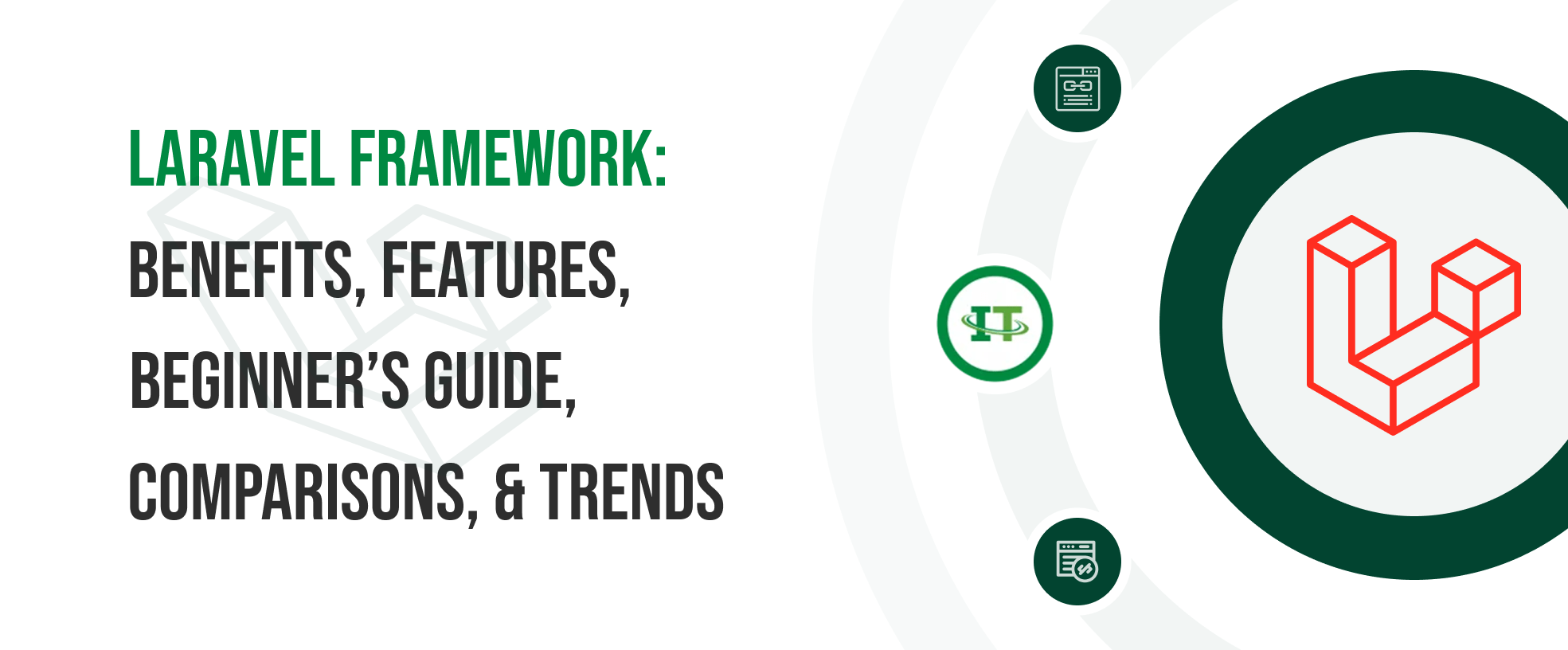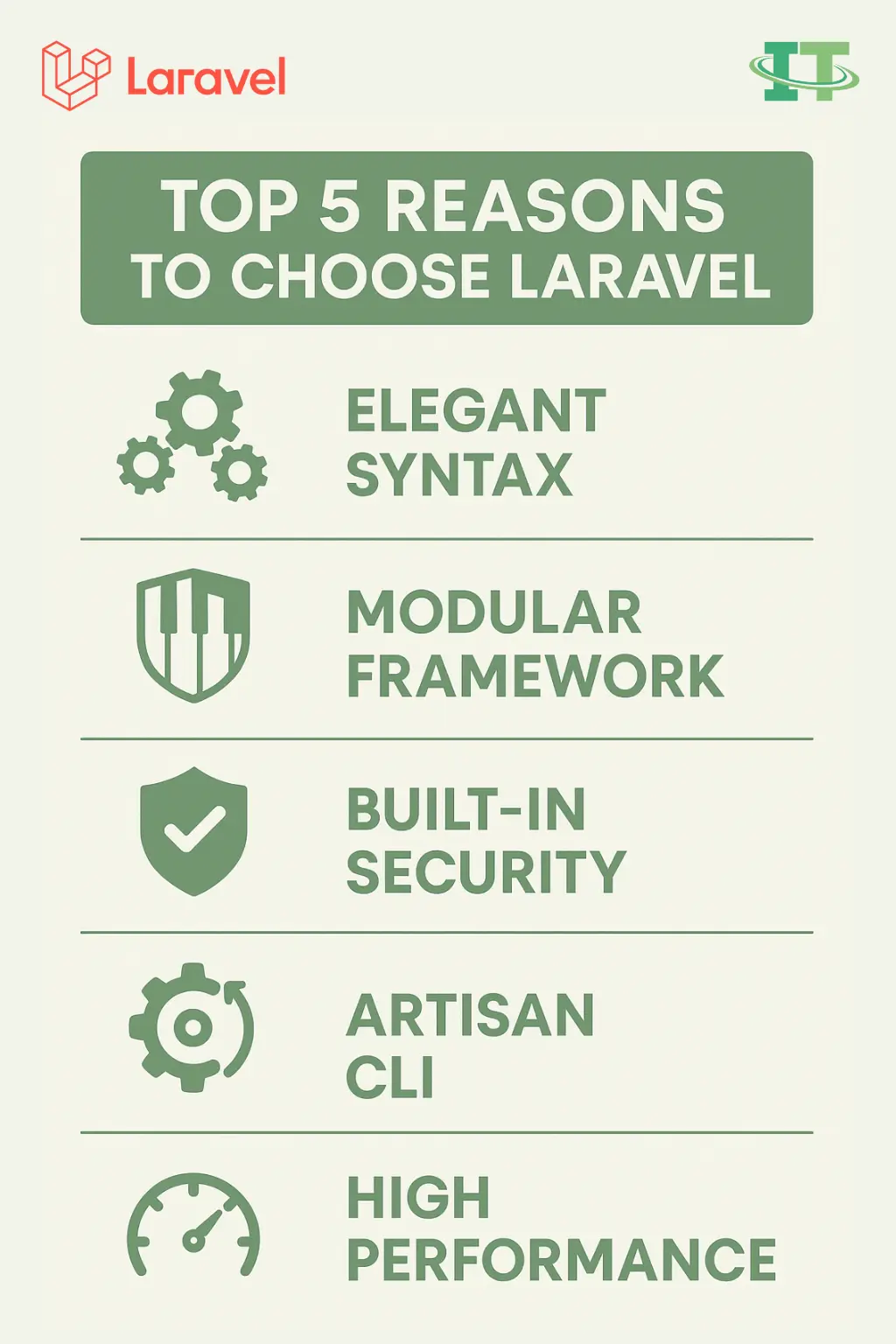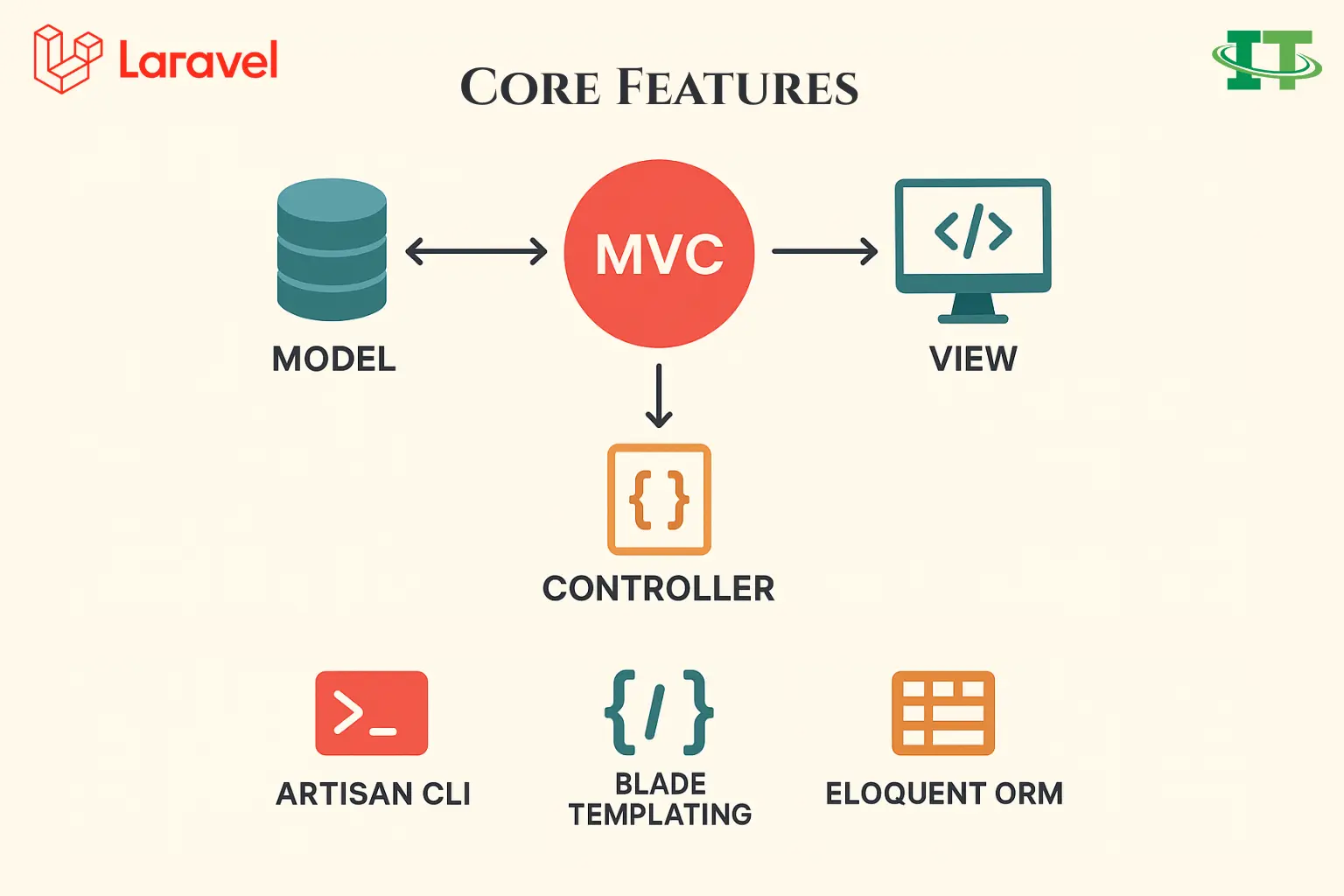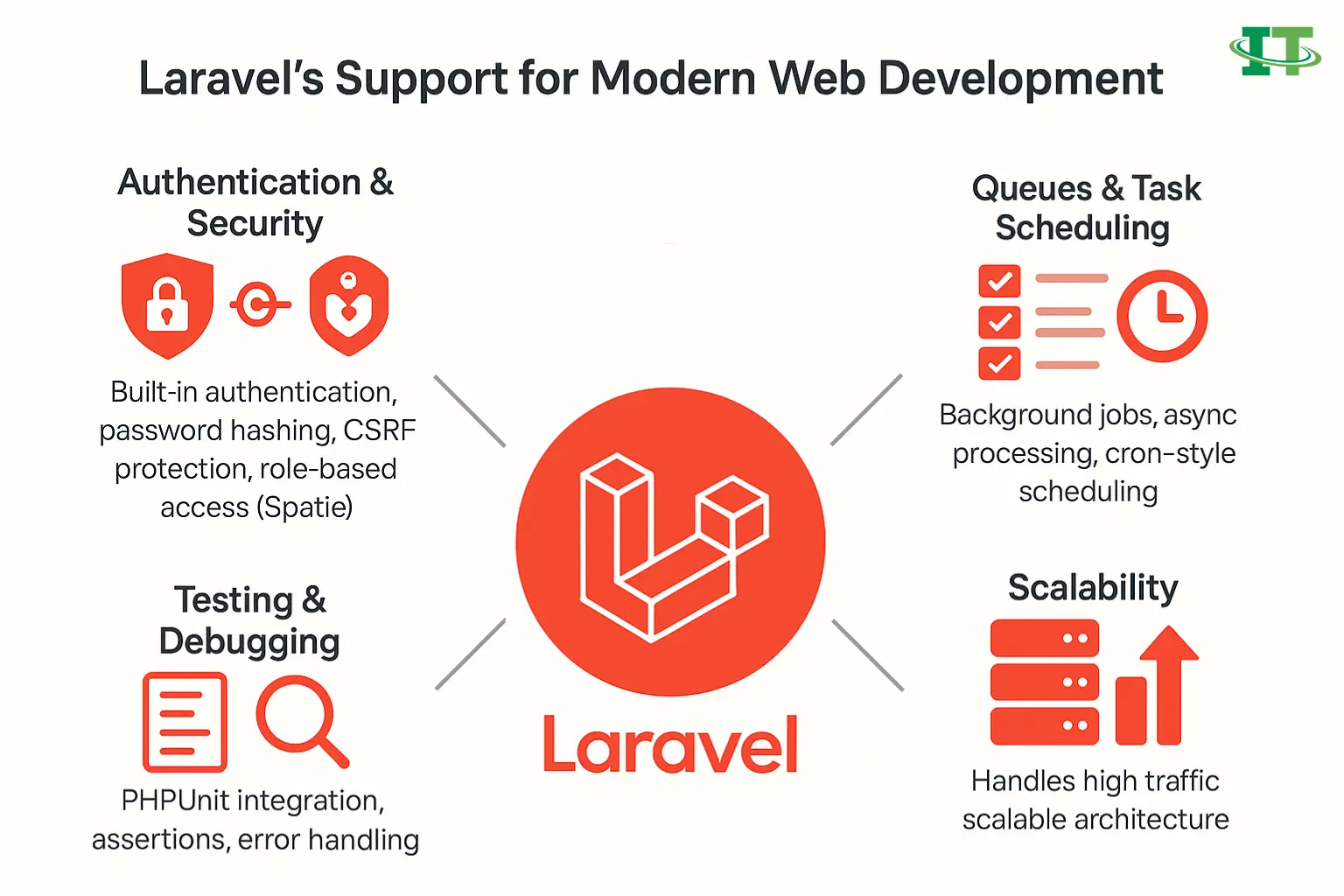What Is Laravel? A Beginner’s Guide To The PHP Web Framework

Laravel is a developer’s productivity powerhouse that builds powerful web apps.
In the world of technology, every developer has that one powerful tool known as Laravel. If you are new to the developer niche or a beginner, have you wondered why Laravel is so popular and gaining more preference from developers? This blog explains Laravel completely, its functions, robust features, and why it is the go-to choice for every developer today.
What Will We Cover?
- How Does Laravel Work?
- Why Choose Laravel For Web Development?
- What Are The Key Benefits of Laravel?
- What Makes Core Laravel’s Features Stand Out?
- How Does Laravel Support Modern Web Development?
- Getting Started With Laravel Framework: A Beginner’s Guide
- Laravel vs. Other PHP Frameworks: Which One Fits You?
- The Future of Laravel: What’s Next For Developers?
If you are just diving into the web development sector, you would have certainly come across Laravel and are excited to know about it. Simply put, the Laravel framework is an open-source PHP web framework founded and created by Taylor Otwell in June 2011. In a short span, it has become one of the most opted-for PHP frameworks by developers.
Laravel seamlessly builds modern web applications with elegance and expressive syntax. It seamlessly links to the ecosystem with rapid development.
Since it was founded a decade ago, it seems to be the go-to choice for developers. Let’s see how it supports modern web development, its core features, and a Laravel step-by-step guide for beginners.
How Does Laravel Work?
The workflow of Laravel allows developers to concentrate more on building significant features. It replaces writing code for each feature for developers and provides a structured, built-in tool. The core function of Laravel is the MVC architecture, which keeps web applications organized. Beyond this core workflow, Laravel also offers many screen behind tasks such authentication, routing, session handling and caching. Together the work-flow enhances developers’ focus more on robust modern web development.
Let’s explore why choosing these built-in Laravel functions is beneficial for your web development.
Why Choose Laravel For Web Development?
Laravel works by offering a developer-friendly open source framework and delivering a structured foundation. Imagine developing your dream web application without writing any code from scratch, with its robust features that Laravel promises you.
Here are some top web development benefits that make developers opt for Laravel:

Did you know? All Laravel versions are provided with bug fixes for 18 months and 2 years[1]for security fixes from their release date.
What Are The Key Benefits of Laravel?
Laravel not only benefits developers, it benefits businesses too. Here are some of the top-notch benefits that win over businesses to invest in Laravel for their web projects.
- Rapid and reliable development: It aids you in delivering your project on time.
- Scalability: Laravel adapts to your business scale from start-ups to high-traffic sites.
- Security: It protects from general risk points through CSRF protection, password hashing, and encryption.
- Customization: It can integrate with third-party tools like API connections, Vue/React, and payment gateways.
- Long-term reliability: It emphasizes stability and trust as backed by a vibrant community, new packages, and frequent updates.
Together, the above-mentioned benefits make Laravel a next-gen framework with scalability, but it is still confusing what makes it stand out. Let’s look into it.
What Makes Core Laravel’s Features Stand Out?
Laravel stands out with the core functions which eases development and boosts productivity. The core tools include MVC architecture, Artisan CLI, Blade templating, and Eloquent ORM, which are framed to automate coding, cut down ERRORS and SUPPORT developers to create robust web applications.

MVC Architecture: The Foundation of Laravel
The MVC architecture is the heart of Laravel, which is a structured pattern that keeps web applications organized. Together, they make it easy for developers to maintain code and applications. We can categorize the responsibilities of the MVC into three unique setups.
Artisan CLI: Your Command-Line Companion
Artisan CLI (Command-Line Interface) is a potent built-in tool in the Laravel framework. Artisan allows developers to generate files and run tasks. For instance, to create a new model for users, the following command helps to simplify it.
php artisan make:model User
Artisan eases the manual work of developers by generating controllers, middleware and even run tests. Artisan is highly supportive in managing database migrations and seeding. For database changes can be done through the command php artisan migrate and inserting sample data for testing through the command php artisan db:seed.
Common Artisan Commands
1. php artisan migrate – Run all database migrations.
2. php artisan db:seed – Seed the database with sample or test data for development.
3. php artisan route:list – Displays all routes, URIs, names, controller actions, and middleware.
Blade Templating Engine: Simple Yet Powerful
- Clean syntax: Builds easier templates to read, debug, and maintain via writing dynamic views free from complex PHP echo commands.
- Template layouts: It can build stable templates by running @extends and @section.
- Logic-driven rendering: It can manage the content for admins, guests, or logged-in users, as well as what they see.
Together, the blade templating engine supports real-time development and aids developers in building powerful web applications.
Blade Directives Examples
The blade directives cut down the demand for raw PHP with error-free code.
@if – defines conditional statements depending on logic.
@foreach – loop over arrays or iterable data.
@include – add reusable template partials.
Eloquent ORM: Effortless Database Interactions
◆ Example: User::where(‘active’, true)->get();
◆ Example: hasMany, belongsTo, and belongsToMany
Basic Eloquent Queries
Eloquent can create streamlined database functions via simple syntax, and it is easily readable.
- Retrieve all records – $users = User::all();
- Get a solo record by ID – $user = User::find(1);
- Sort database with conditions – $activeUsers = User::where(‘active’, true)->get();
- Build a new record – User::create([‘name’ => ‘John’, ’email’ => ‘john@example.com’]);
Let’s see how the above built-in tools support developers in building modern web applications.
How Does Laravel Support Modern Web Development?
Laravel is not simply a back-end development framework; it supports multi-functional web development benefits for full-stack web applications. It powers built-in authentication monitors, queues, task scheduling, and PHPUnit integration. Well-built CSRF protection provides security, and a scalable architecture handles massive traffic.

Built-In Authentication and Security
- Quick-setup – With a single command, Laravel set up authenticated systems that seamlessly runs login and sign up flow, with the help of UI package or using Breeze/Fortify/Jetstream.
- Powered security – It holds password hashing, data encryption, and CSRF protection, defense against general security holes.
- Scalable – Adapt to all scale business projects and can expand as their business grows with ensured protection.
- Spatie Permission – Developers can assign and manage role-based access control seamlessly.
Note: If you do not have it installed, you can run this command via Composer to install Spatie:
composer require spatie/laravel-permission
Authentication Setup Example
Laravel can perform authentication setup with simple artisan commands php artisan make:auth. After that, developers can test the login and registration pages instantly and also can customize it based on their design.
For example: As Laravel has built-in authentication scaffolding, developers can generate the essential code by running this command php artisan make:auth .
Note: This command is really useful, but only until Laravel 7. If you are using any later versions (Laravel 7+), then you will need to install laravel/ui with this:
composer require laravel/ui
php artisan ui vue –auth
The simple artisan command can generate all essential views and boilerplate code for authentication, and run it instantly. As a result, developers can get,
- Login & registration forms
- Controllers (LoginController, RegisterController)
- Routes for authentication
- Password reset functionality
Queues and Task Scheduling
- Asynchronous operations – Provides fast and responsive web applications through queues that handle tasks in the background.
- Task scheduling – Effectively automate repetitive jobs, which include notification, report generation, and database cleaning.
- Queue Configuration – Provides an API for defining and running queued jobs on multiple backends i.e database, Redis, SQS, etc., which really reduces the need of using boilerplate and custom code.
Testing and Debugging Tools
- PHPUnit Integration – It can integrate with PHPUnit, thus providing easy unit and feature testing.
- Built-in assertions – Fast testing for data states, request response, and app activities.
- Error handling – Quick and clear error reporting enables developers to locate and resolve errors seamlessly.
Basic Test Example
The built-in testing and debugging features make it seamless to ensure error-free web applications.
- Create a Test – php artisan make:test UserTest
- Write Assertions – $this->assertDatabaseHas(‘users’, [’email’ => ‘john@example.com’]);
- Run Tests – php artisan test
If you are a beginner and excited to use Laravel, the step-by-step guide below will help you start your developer journey.
Getting Started With Laravel Framework: A Beginner’s Guide
Are you eager to try Laravel? Here is the Laravel guide for beginners. Helps you with the basics, from installing the PHP framework through Composer to developing your first project. Through understanding and following the below laravel basics, even beginners can build modern scalable web applications.

Prerequisites and Installation
| Requirement | Version | Why needed |
|---|---|---|
| PHP | 8.1 + | Laravel uses PHP to run server-side logic for fast and scalable apps. |
| Composer | Latest | Composer can handle PHP dependencies and run Laravel smoothly. |
| Database | MySQL, SQLite, PostgreSQL, etc. | A database is crucial for Laravel to manage data and run queries. |
| Vue.js | Latest | Prominent tools like Vue.js or Laravel Mix are required to facilitate front-end features. |
- PHP requirement – Verify PHP 8.1 or higher is installed for full Laravel compliance.
- Composer – Set up Composer; as it is used to install Laravel packages and PHP dependencies.
- Database – Must possess a MySQL, PostgreSQL, or SQLite installation for the project database.
Composer Installation Code
The code below ensures the composer sets up the system-wide configuration and is ready to use with Laravel.
- Step 1 – Dependency manager for PHP using cURL
- curl -sS https://getcomposer.org/installer | php
- Step 2 – Install Laravel globally using
- mv composer.phar /usr/local/bin/composer
- Step 3 – Verify installation using
- composer -V
Creating Your First Laravel Project
Creating a new Laravel project is seamless with Composer. You have to navigate to the folder to create your Laravel project. It can manage the dependencies automatically while the setup is in progress. The project creation can be done in a short span of time to begin developing your robust web application.
Project Creation Command
- Step 1 – The following command helps you create your new Laravel project:
- composer create-project laravel/laravel my-app
- Step 2 – In the above command, “my-app” is the name for your new Laravel project. You can change their project name by replacing “my app” in the command. After the installation is done, navigate to your project directory with the code:
- cd my-app
Now, the new Laravel project is ready to explore.
Basic Configuration and Running The Server
The first step for the developer when starting a new Laravel project is configuring your environment. Laravel stores the database credentials, application URL, and environment type in a unique file named .env . Once the cloning of the Laravel project has been completed, you have to create the below to ensure that the essential environment variables are included:
In macOS / Linux: cp .env.example .env #
In Windows (PowerShell): copy .env.example .env
Developers have to edit important values in .env . Example of updating environment variables:
APP_NAME="MyApp"
APP_ENV=local
APP_KEY= # you’ve to add key here after generating
APP_URL=https://127.0.0.1:8000
DB_CONNECTION=mysql
DB_HOST=127.0.0.1
DB_PORT=3306
DB_DATABASE=myapp_db
DB_USERNAME=myuser
DB_PASSWORD=mypassword
Moreover, you must generate an APP_KEY (which will be used above in APP_KEY= , which will automatically update the .env file through the following command:
php artisan key:generate
If you are handling a new project, then you have to install all composer dependencies and run migrations. This results in creating database tables.
composer install
php artisan migrate
Server Run Example
Developers can run Laravel’s development server once the basic environment configuration has been successfully completed. The command below in the project folder lets you preview your app in the browser.
php artisan serve
If you are seeing the output like below, now you can see your Laravel application in action via your browser through the URL given.
Laravel development server started: https://127.0.0.1:8000
Now let’s compare the robust Laravel with other PHP frameworks.
Laravel vs. Other PHP Frameworks: Which One Fits You?
Selecting the right one for your web app development among the PHP frameworks is quite difficult. As each one of them serves effective functions in certain aspects, let’s find out how Laravel stands out among other PHP frameworks and why it’s the best fit for you.
| Framework | Strengths | Weaknesses | Best for |
|---|---|---|---|
| Laravel | Clean syntax, built-in tools, active community support, and quick development. | It has more framework files and more boot time for small web apps. | Start ups |
| Symfony | Enterprise-level performance and long-term support. | Steeper learning curve and slower for prototypes. | Large-scale and enterprise-grade applications. |
| Codeigniter | Simple and lightweight. | Lacks modern eco-systems and limited built-in features. | Small apps are for beginners who require simplicity. |
| Yii | Robust performance and highly secure. | Less beginner-friendly and smaller community support. | E-commerce and high security projects. |
Laravel vs. Symfony
Laravel prioritizes fast development with elegant syntax and built-in options. It can be handled by beginners easily.
Symfony provides an organized approach enhancing developers maximum flexibility. It can handle complex and enterprise-level projects adaptable for experienced ones.
Moreover, Laravel comes with a bundle of built-in features that speed up the app-building process and thus require minimal time. Symfony can handle deep customization for large, scalable, and long-term projects.
Laravel vs. CodeIgniter
Eloquent ORM, Blade templating, and queues are the remarkable features included in Laravel. It performs well for apps with lots of features.
CodeIgniter is ideal for small prototypes as it has scalability limitations. Thus, it performs well for quick and small prototypes.
Laravel’s ability to accommodate a rich ecosystem reduces the amount of manual effort required for testing and authentication. Even though CodeIgniter can quickly set up and run web applications easily, it requires manual effort and time.
Laravel vs. Yii
Laravel implements Eloquent ORM for natural, semantic queries. It is best in terms of maintainability. The community support for Laravel allows developers to learn quickly and troubleshoot more easily.
Yii enhances faster performance in a significant environment and focuses less on elegant syntax. It renders for raw performance needs. Yii has a small active community, thus, learning, collaboration, and the discussion opportunities are minimal while Laravel offers active community support through forums, GitHub, and QnA support in Stack Overflow[2].

Now, let’s explore the upcoming updates and their significant features in the future Laravel releases.
The Future of Laravel: What’s Next For Developers?
The consistent updates and new releases allow Laravel to build advanced and customized apps. It levels up the modern web development process. It constantly improves performance, integrating with emerging tech thus enhancing it as a leading open-source PHP solution.
Upcoming Releases and Improvements
- Laravel 13 is the upcoming version concentrating on speed, cut down memory usage and improve developer and user experience.
- It will come with high-performance routing, quick database queries, and optimized caching.
Community and Ecosystem Growth
- Laravel’s proactive communities like Laravel.io[3], GitHub[4], Laracast[5], etc., enables thousands of packages to expand functionality.
- Laracon fosters collaboration, enhancing a worldwide network for developers.
- Ecosystem has tutorials, starter kits, and plugins, and it confirms web development benefits.
Final Thoughts
Among other PHP frameworks, Laravel still keeps the crown with constant evolution. It seems to be the powerhouse for developers and empowers them to develop scalable, powerful modern web applications.
The dynamic community and future-looking tools promises to be a reliable choice for projects of all scales. If you are a junior developer or planning to build complex web apps, it’s high time to dive into Laravel’s robust features and embrace the modern web apps.
TLDR – Key Takeaways:
- Laravel is a well-structured PHP framework with effective built-in tools.
- Offers a quick development process with clean syntax.
- Inbuilt robust tools: Artisan CLI, Blade templating, and Eloquent ORM.
- An active ecosystem and a proactive community constantly support developers.
- Laravel 13 is going to come with high performance and scalability.
- Best suits for all scale web projects.
Frequently Asked Questions (FAQs)
Still need answers? Let’s break down your questions!
1. What is Laravel in simple words?
Laravel is an open source PHP framework that has built-in tools enhancing authentication, database handling, faster app flow, and is seamless to build. It simplifies the web development process and is free from manual coding.
2. How easy is it to learn the Laravel framework?
Laravel requires basic PHP knowledge; beginners can learn it quickly through an active community, which makes it reliable for everyone. It has a friendly interface, due to its expressive syntax, clean coding, and active community support, making it reliable for everyone.
3. Is Laravel used for front-end or back-end?
Generally, it is a back-end framework, managing server-side logic, interactive database, and API development. It can also perform with front-end tools, including Blade and Vue.js.
4. What is the difference between Laravel and PHP?
The difference between Laravel and PHP is that PHP is a base language used to write code for server-side web development, while Laravel is a framework created using PHP to ease web app development.
5. What is the Laravel framework used for?
Laravel supports developers to build modern web applications using the built-in PHP language.
How Can iCommuneTech Help You?
We specialize in offering powerful digital solutions for your dynamic web application requirements. Our competent professionals deliver robust solutions tailored to your needs.
Now, are you ready to start your new Laravel project with us?
Contact us today for further details!
Irshad Pathan

Web Development Expert
Irshad is a senior technical expert at iCommuneTech. He manages the iCommuneTech's Web Development Team, and has hands-on expertise in web development, Laravel development, Logistics, fleet management, and Supply Chain Management. He mentors the in-house team and enjoys describing his experience in words.
